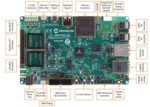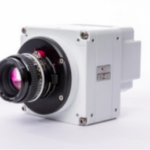Teledyne FLIR IIS is pleased to announce SightBase – an advanced Software-as-a-Service (SaaS) platform that accelerates the design-in cycles for imaging systems and reduces customer spending. This new platform includes a virtual lab that increases user confidence when selecting a system configuration to meet their vision application requirements. SightBase, now available online, delivers an intuitive […]
Image processing
Single-chip MPU bring vision AI to next-gen robotics
Renesas Electronics Corporation has expanded its popular RZ Family of microprocessors (MPUs) with a new device targeting high-performance robotics applications. Offering the highest levels of performance within the family, the RZ/V2H enables both vision AI and real-time control capabilities. The device comes with a new generation of Renesas proprietary AI accelerator, DRP (Dynamically Reconfigurable Processor)-AI3, […]
The top computer vision tools for embedded systems
Computer vision is reaching new levels, far beyond basic image processing. This is thanks to the integration of artificial intelligence. AI now enables computers and systems to derive meaningful information from digital images that can be used in advanced industries. Currently, one of the most common applications is in security and surveillance. A computer vision […]
MPU hosts MIPI CSI-2, traditional parallel camera interface
The embedded market has a need for a higher performing, yet lower power artificial intelligence (AI) solutions that can be deployed at the edge, where power consumption is often at a premium. AI solutions often require advanced imaging and audio capabilities which are typically found only on higher-performing multi-core microprocessors that, unfortunately, also consume much […]
Streaming 4x cameras with small carrier board: Fast Prototype
Embedded vision components are ever-popular and being incorporated into a plethora of applications. What all these applications have in common is the need to pack more functionality into tight spaces. Often, it is advantageous for these systems to make decisions on the edge. To enable such systems, including the ability to prototype quickly, Teledyne FLIR has introduced the […]
Smart parking reference design incorporates machines learning
XMOS announced its reference solution for Automatic License Plate Recognition (ALPR), designed to move ALPR in parking garages away from complex, resource-intensive hardware and towards simple on-device AI. Developed in partnership with computing specialist Cloudtop, the reference design can read slow-moving license plates at a distance of 3-5 meters with high accuracy. Thanks to […]
Sensor simulation software provides high-rez visualization for testing autonomous vehicle functions
dSPACE is launching AURELION, a new sensor simulation solution that provides high-resolution visualization for testing and validating functions for autonomous driving. The solution, which can be operated either in the cloud or locally, generates photorealistic images in real-time for camera simulation and, using ray tracing, an exact environment for radar and lidar simulation. With AURELION, […]
Image classification models deliver improved run time on Intel Cascade Lake CPUs
A new set of industry-leading image classification models, dubbed DeciNets, run on Intel Cascade Lake CPUs. Deci’s proprietary Automated Neural Architecture Construction (AutoNAC) technology automatically generated the new image classification models that significantly improve all published models and deliver more than 2x improvement in runtime, coupled with improved accuracy, as compared to the most powerful […]
New Phantom S991 machine vision high-speed camera
Vision Research, a leading manufacturer of digital high-speed imaging systems, brings extreme throughput to machine vision applications with the introduction of the Phantom S991 Machine Vision camera. The Phantom S991 employs CoaXPress-over-Fiber technology to deliver up to 9 Gpx/sec (70 Gbps). This throughput translates to over 900 frames per second (fps) at a full 9 Mpx resolution of […]
Robot solution for automating the lettuce harvest
Lettuce is a valuable crop in Europe and the USA. But labor shortages make it difficult to harvest this valuable field vegetable, as sourcing sufficient seasonal labor to meet harvesting commitments is one of the sector’s biggest challenges. Moreover, with wage inflation rising faster than producer prices, margins are very tight. In England, agricultural technology […]










